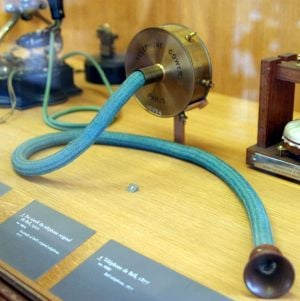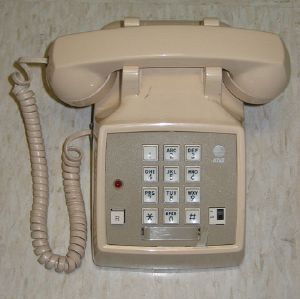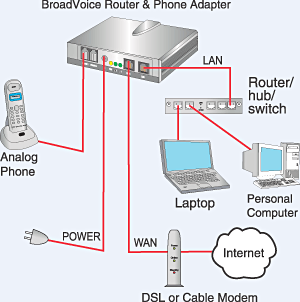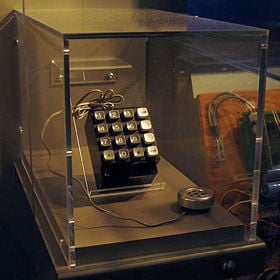Telephone
 From Nwe
From Nwe 
The telephone (or phone) (from Greek: tele = far away; phone = voice) is a telecommunications device that is used to transmit and receive sounds (most commonly voice and speech) across distances. Most telephones operate through the transmission of electric signals over a complex telephone network that allows almost any phone user to communicate with almost any other. The communication links may be established by wire connections, radio waves, or broadband Internet. In addition, basic phone service is often enhanced with such features as voicemail, caller ID, teleconferencing, direct distance dialing, and last call return. Unfortunately, the phone system is also misused through such activities as fraud, prank calls, bomb threats, "phreaking," and "war dialing."
Introduction
An elementary telephone system consists of three basic elements:
- each subscriber's equipment, which converts sound to electrical signals and vice versa, and which allows the subscriber to initiate or answer a call;
- a central switching facility that interconnects the subscribers;
- wiring or other equipment that connects the subscribers to the central switching facility.
A subscriber may be connected to the telephone network in one of three principal ways:
- Historically, and still very commonly, by dedicated physical wire connections run in overhead or underground cables.
- By radio, as in a cordless, cellular, satellite, or radio telephone.
- By voice over Internet protocol (VoIP) telephones, which use broadband Internet connections.
Between end users, transmissions across a network may be carried by fiber optic cable, landline cable, point-to-point microwave or satellite relay.
Until relatively recently, a "telephone" generally referred only to landlines. Cordless and mobile phones are now common in many places around the world, with mobile phones expected to gradually displace the conventional landline telephone. Unlike a mobile phone, a cordless phone is considered landline because it is usable only within a short distance of a personal or domestic base station connected to a fixed phone line.
History
The identity of the inventor of the electric telephone remains in dispute. Antonio Meucci, Johann Philipp Reis, and Alexander Graham Bell, among others, have all been credited with the invention. Moreover, the early history of the telephone is a confusing morass of claims and counterclaims, which was not clarified by the huge mass of lawsuits that hoped to resolve the patent claims of individuals. Much money was expended, particularly in the Bell Telephone companies, and the aggressive defense of the Bell patents resulted in much confusion. Additionally, the earliest investigators preferred publication in the popular press and demonstration to investors instead of scientific publication and demonstration to fellow scientists.
It is important to note that there is probably no single "inventor of the telephone." The modern telephone is the result of the work of many, all worthy of recognition of their contribution to the field. Recently, however, the British government announced that it now recognizes (primarily for educational purposes) Antonio Meucci (see below) as the 'first inventor' of the telephone.
A timeline of the invention and development of the telephone is given below.
1849-1875
- 1849: Antonio Meucci demonstrates a device later called a telephone to individuals in Havana. (It is disputed if this was an electric telephone.)
- 1854: Charles Bourseul publishes a description of a make-break telephone transmitter and receiver but does not construct a working instrument.
- 1854: Meucci demonstrates an electric telephone in New York [2].
- 1860: Johann Philipp Reis demonstrates a "telephon" using a pressure contact transmitter after Bourseul's make-break design and a knitting needle receiver. Witnesses said they heard human voices being transmitted.
- 1860: Meucci demonstrates his telephone on Staten Island.
- 1861: Reis manages to transfer voice electrically over a distance of 340 feet.
- 1864: In an attempt to give his musical automaton a voice, Innocenzo Manzetti invents the 'speaking telegraph.' He shows no interest in patenting his device, but it is reported in newspapers.
- 1865: Meucci reads of Manzetti's invention and writes to the editors of two newspapers claiming priority and quoting his first experiment in 1849. He writes, "I do not wish to deny Mr. Manzetti his invention, I only wish to observe that two thoughts could be found to contain the same discovery, and that by uniting the two ideas one can more easily reach the certainty about a thing this important." Manzetti, if he read Meucci's implicit suggestion to collaborate, does not respond.
- 1871: Antonio Meucci files a patent caveat (a statement of intention to patent).
- 1872: Elisha Gray founds Western Electric Manufacturing Company.
- 1872: Prof Vanderwyde demonstrates Reis's telephone in New York.
- July 1873: Thomas Edison notes variable resistance in carbon grains due to pressure and builds a rheostat based on the principle. He, however, abandons it because of its sensitivity to vibration.
- May 1874: Gray invents an electromagnet device for transmitting musical tones. Some of his receivers use metallic diaphragms.
- December 1874: Gray demonstrates his musical tones device at the Presbyterian Church in Highland Park, Illinois, and lectures on the possibility of transmitting speech.
- June 2, 1875: Alexander Graham Bell transmits the sound of a plucked steel reed using electromagnet instruments.
- July 1, 1875: Bell uses a bidirectional "gallows" telephone that could transmit "indistinct but voicelike sounds" but not clear speech. Both the transmitter and receiver were identical membrane electromagnets.
- 1875: Edison experiments with acoustic telegraphy and in November builds an electrodynamic receiver but does not exploit it.
1876-1878

- February 11, 1876: Elisha Gray invents liquid transmitter for use with a telephone, but does not build one.
- February 14, 1876 (about 9:30 A.M.): Gray or his lawyer brings to the Patent Office Gray's caveat for the telephone. (A caveat was a notice of intent to file a patent application at a later date.)
- About two hours later, Bell's lawyer brings Bell's patent application for the telephone to the Patent Office. Bell's lawyer requests that it be registered immediately in the cash receipts blotter.
- Another two hours later, Gray's caveat was registered in the cash blotter. Although Gray could have converted his caveat into a patent application, he did not do so based on his lawyer's advice and involvement with acoustic telegraphy. As a result, the patent was awarded to Bell. [1]
- March 7, 1876: Bell's U.S. patent 174,465 for the telephone is granted.
- March 10, 1876: Bell transmits speech, "Mr. Watson, come here, I want you," using a liquid transmitter described in Gray's caveat and an electromagnetic receiver described in Gray's July 1875 U.S. patent 166,095.
- May 16, 1876: Edison files first patent application for acoustic telegraphy.
- October 1876: Edison tests his first carbon microphone.
- January 20, 1877: Edison "first succeeded in transmitting over wires many articulated sentences" using carbon granules as a pressure-sensitive variable resistance, under the pressure of a diaphragm (Josephson, 143).
- January 30, 1877: Bell's U.S. patent 186,787 is granted for an electromagnetic telephone with transmitter and receiver using steel diaphragms and a call bell.
- March 4, 1877: Emile Berliner invents a microphone based on "loose contact" between two metal electrodes, an improvement on the Reis telephone, and in April 1877 files a caveat of an invention in process.
- April 27, 1877: Edison files for a patent on a carbon transmitter that included the first use of an induction coil or transformer with the transmitter and battery in the primary circuit. The patent was granted after a 15 year delay due to litigation. In 1892, a federal court ruled Edison and not Berliner was the inventor of the carbon transmitter. Edison's carbon transmitter and Bell's electromagnetic receiver were used by the Bell system for many decades thereafter (Josephson, 146).[2]
- June 4, 1877: Berliner files telephone patent application that includes a carbon microphone transmitter.
- December 1, 1877: Western Union enters the telephone business using Edison's superior carbon microphone transmitter.
- January 1878: First North American telephone exchange opened in New Haven, Connecticut.
- February 4, 1878: Edison demonstrates telephone between Menlo Park, New York, and Philadelphia, a distance of 210 kilometers.
- June 14, 1878: The Telephone Company Ltd (Bell's patents) is registered in London. Opened in London on August 21, 1879 - Europe's first telephone exchange.
- September 12, 1878: The Bell Telephone Co. sues Western Union for infringing on Bell's patents.
1879-1919
- Early months of 1879: The Bell Telephone Co. is near bankruptcy and desperate to get a transmitter to equal Edison's carbon transmitter.
- 1879: Bell merges with the New England Telephone Company to form the National Bell Telephone Company.
- 1879: Francis Blake invents a carbon transmitter similar to Edison's, thereby saving the Bell company from extinction.
- August 2, 1879: The Edison Telephone Company of London Ltd is registered. Opened in London on September 6, 1879.
- September 10, 1879: Connolly and McTighe patent a "dial" telephone exchange (limited in the number of lines to the number of positions on the dial).
- 1880: National Bell merges with others to form the American Bell Telephone Company.
- 1882: A telephone company, an American Bell affiliate, is set up in Mexico City.
- 1885: American Telephone and Telegraph Company (AT&T) is formed.
- 1886: Gilliland's automatic circuit changer is put into service between Worcester and Leicester, allowing one operator to run two exchanges.
- January 13, 1887: The U.S. Government moves to annul the patent issued to Alexander Graham Bell, on the grounds of fraud and misrepresentation. Bell remanded for trial.
- 1899: AT&T becomes the overall holding company for all the Bell companies.
- November 2, 1889: A. G. Smith patents a telegraph switch that provides for trunks between groups of selectors, allowing fewer trunks than there are lines, and automatic selection of an idle trunk.
- March 10, 1891: Almon Strowger patents the "Strowger switch"—the first automatic telephone exchange.
- October 30, 1891: The Strowger Automatic Telephone Exchange Company is formed.
- May 3, 1892: Edison awarded patents for the carbon microphone, against applications lodged in 1877.
- November 3, 1892: The first Strowger switch goes into operation in LaPorte, Indiana, with 75 subscribers and a capacity for 99.
- February 27, 1901: The U.S. Court of Appeals declares void Berliner's patent of the Bell telephone system.
- 1915: Vacuum tubes used in coast-to-coast telephone circuits.
- 1919: AT&T installs the first dial telephones in the Bell system, in Norfolk, Virginia. The last manual telephones in the system were not converted to dial until 1978.
1927-2005
- 1927: First public trans-Atlantic phone call (via radio), between New York City and London.
- 1935: First telephone call around the world.
- 1941: Touch Tone® dialing (DTMF) is introduced for operators in Baltimore, Maryland.
- 1946: National numbering plan (area codes).
- 1946: First commercial mobile phone call.
- 1946: Bell Labs develops the germanium point contact transistor.
- 1951: Direct Distance Dialing (DDD) is first offered at Englewood, New Jersey, to reach 11 major cities across the United States. This service grew rapidly across major cities during the 1950s.

- 1955: The laying of trans-Atlantic cables begins.
- 1958: Modems used for direct connection via voice phone lines.
- 1961: Touch Tone® released to the public.
- 1962: T-1 service in Skokie, Illinois.
- 1970: Modular telephone cords and jacks are introduced.
- 1972: U.S. patent 3,663,762 granted to Amos Joel of Bell Labs, inventor of the "cellular mobile communication system."
- 1975: Last manual telephone switchboard in Maine is retired.
- 1982: Caller ID patented by Carolyn Doughty of Bell Labs.
- 1987: Asymmetric Digital Subscriber Line (ADSL) is introduced.
- 1993: Telecom Relay Service becomes available for the disabled.
- 1995: Caller ID implemented nationally in the United States.
- 2002: The U.S. House of Representatives, in House Resolution 269 (dated June 11), recognizes Meucci as the first inventor of the telephone. The Parliament of Canada retaliates by passing a bill recognizing Canadian immigrant Alexander Graham Bell as the only inventor of the telephone.
- 2005: Mink, Louisiana, gets phone service—the last community in the United States to do so.
Digital Telephony
Public Switched Telephone Network
The traditional telephone network, known as the Public Switched Telephone Network (PSTN), has gradually developed toward digital telephony, thereby improving the capacity and quality of the network. End-to-end analog telephone networks were first modified in the 1970s by upgrading long-haul transmission networks with SONET technology and fiber optic transmission methods. Digital transmission made it possible to carry multiple digitized switched circuits on a single transmission medium—a capability known as "multiplexing." Today, the end instrument remains analog, but the analog signals reaching the central office (or Serving Area Interface) are typically converted to digital signals.
VoIP Telephony

Internet telephony, or Voice over Internet Protocol (VoIP), competes with and appears to be rapidly replacing PSTN. VoIP technology, grouped under digital telephony, uses a broadband Internet connection to transmit conversations as data packets. It may also compete with mobile phone networks by offering free or lower cost connections, but it requires equipment that is connected to the Internet. VoIP is also used on private wireless networks which may or may not have a connection to the outside telephone network.
Wireless phone systems
The term "wireless" can refer to any telephone that uses radio waves for transmission, but it is primarily used for cell phones. In the United States, wireless companies tend to use the term wireless to refer to a wide range of services, while the cell phone itself is called a mobile phone, mobile, PCS (Personal Communications Service) phone, cell phone, or simply cell. The trend is now moving toward "mobile." The changes in terminology are partially the result of providers using different terms in marketing, to differentiate newer digital services from older analog systems and services of one company from another.
Cordless telephone
Cordless telephones, invented by Teri Pall in 1965, consist of a base unit that connects to the landline system and also communicates with remote handsets by low-power radio. This permits use of the handset from any location within range of the base. Given that power is required to transmit to the handset, the base station is connected to an electronic power supply. Consequently, cordless phones typically do not function during power outages.
Initially, cordless phones used the 1.7 megahertz (MHz) frequency range to communicate between the base and the handset. Because of quality and range problems, these units were soon superseded by systems that used frequency modulation (FM) at higher frequency ranges—49 MHz, 900 MHz, 2.4 gigahertz (GHz), and 5.8 GHz. The 2.4 GHz cordless phones can interfere with certain wireless "LAN" (local area network) protocols, due to usage of the same frequencies. On the 2.4 GHz band, several "channels" are utilized in an attempt to guard against degradation in the quality of the voice signal due to crowding. The range of modern cordless phones is normally on the order of a few hundred meters.
Mobile phones
Most modern mobile phone systems are cell-structured. Radio waves are used to communicate between a handset and nearby cell sites. When a handset gets too far from a cell site, a computer system commands the handset and a closer cell site to take up the communications on a different channel without interrupting the call.
Radio frequencies are a limited, shared resource. The higher frequencies used by cell phones have advantages over short distances. Connection distance is somewhat predictable and can be controlled by adjusting the power level. By using just enough power to connect to the "nearest" cell site, phones using one cell site will cause almost no interference with phones using the same frequencies on another cell site. The higher frequencies also work well with various forms of multiplexing, which allows more than one phone to connect to the same tower with the same set of frequencies.
Satellite phones
To establish communications from remote locations and disaster zones, where constructing a cell network would be too unprofitable or difficult, some mobile telephones are set up to communicate directly with an orbiting satellite. Such devices tend to be bulkier than cell-based mobile phones, as they require a large antenna or satellite dish for communicating with the satellite, but they do not require ground-based transmitters.
Semi-Cordless Phone
There are phones that work as cordless phones when near their corresponding base station (and sometimes other base stations), and they work as wireless phones when in other locations. For a variety of reasons, however, they did not become popular.
Some kinds of cordless phones work like cellular phones but only within a small private network covering a building or group of buildings. These kinds of systems, using VoIP, are popular in hospitals and factories where the same wireless network can be used for both data and voice.
Telephone hacking and exploitation
Fraud, prank calls, bomb threats
The telephone system has long been beset with such abusive activities as fraud, prank calls, bomb threats, and so forth. Fraud may take any of several forms: a consumer attempting to defraud the telephone company; the telephone company attempting to defraud consumers; or a third party attempting to defraud either of them. A prank call (or crank call) is often a practical joke, but it also takes the form of harassment. The telephone is also used to deliver bomb threats or demand ransom money. Such threats, whether made seriously or jokingly, carry severe legal penalties.
Phreaking
"Phreaking" is a slang term coined to describe the activity of a subculture of people who study, experiment with, and exploit telephone systems for the sake of hobby or utility. The term "phreak" is a portmanteau of the words "phone" and "freak." It may also refer to the use of various audio frequencies to manipulate a phone system. Phreaking is often considered similar to computer hacking, and they are sometimes grouped together as the "H/P culture" (for Hacking and Phreaking culture).

Early phreaks, such as Joybubbles (Joe Engressia), started developing a rudimentary understanding of how the phone system works. Joybubbles taught himself to whistle a tone (2600 hertz) that would cause a trunk line to reset itself. John Draper discovered, through his friend Joybubbles, that the free whistles given out in Cap’n Crunch cereal boxes made exactly a 2600-Hz tone when blown. This allowed control of phone systems that worked on "single-frequency" (SF) controls. One could produce a long whistle to reset the line, and then dial with groups of whistles (a short one for a "1"; two short ones for a "2"; and so on). This was the predecessor of "multi-frequency" (MF) controls, or "MFing," which became common after the Bell System (in 1964) released the frequencies of tones in a technical journal.
An early phreaking tool was the "blue box," an electronic device that simulates a telephone operator's dialing console. It functioned by replicating the tones used to switch long-distance calls and using them to route the user's own call, bypassing the normal switching mechanism. The blue box was typically used to get free telephone calls. The blue box got its name because the first device confiscated by Bell System security was in a blue plastic case. These devices were not just the domain of "pranksters" and "explorers"; others (such as the Mafia) used them to make free phone calls for criminal purposes. Blue boxes no longer work in most western nations, as the switching system is now digital and involves "out-of-band signaling" that cannot be accessed from the line a person is using [3].
War dialing
"War dialing" (or wardialing) refers to the act of using a modem to dial every telephone number in a local area to find out where computers may be available, then attempting to access them by guessing passwords. The name for this technique refers to the 1983 film WarGames, in which the protagonist programs his computer to dial every telephone number in Sunnyvale, California, to find other computer systems. The technique itself predates the film, but the term "war dialing" gained rapid popularity in the computing culture [3].
In a related technique, called "demon dialing," a computer was programmed to repeatedly dial a number (usually to a crowded modem pool) in an attempt to gain access immediately after another user had hung up. The terms demon dialing and war dialing are sometimes used synonymously.
A more recent phenomenon is "war driving," involving the search for Wi-Fi wireless networks from vehicles on the road. War driving was named after war dialing, as both techniques involve brute-force searches to find computer networks.
Some additional equipment and components of telephone systems
- Answering machine
- Basic exchange telecommunications radio service
- Call center
- Competitive local exchange carrier (CLEC)
- Electronic Switching System (ESS)
- Emergency telephone
- Foreign exchange service
- Incumbent local exchange company (ILEC)
- Key system
- Local exchange company (LEC)
- Modem
- Payphone
- Public Switched Telephone Network (PSTN)
- Private line
- Private branch exchange (PBX)
- Station set
- Telecommunications Device for the Deaf (TDD or TTY)
- Telegraph
- Telephone switchboard
Notes
- ↑ Hounshell, David A. 1975. "Elisha Gray and the Telephone: On the Disadvantages of Being an Expert." Technology and Culture 16 (2):133-161.
- ↑ Edison, Thomas A. 1880. The Speaking Telephone Interferences, Evidence for Thomas A. Edison, Vol. 1 [jpg image], [cited 21 April 2006]. [1]
- ↑ Wargames, Wardialing, Wardriving, and the Emerging Market for Hacker Ethics
References
ISBN links support NWE through referral fees
- Coe, Lewis. The Telephone and Its Several Inventors: A History. McFarland, N.C., 1995. ISBN 0786401389
- Evenson, A. Edward. The Telephone Patent Conspiracy of 1876: The Elisha Gray - Alexander Bell Controversy. McFarland, N.C., 2000. ISBN 0786408839
- Baker, Burton H. The Gray Matter: The Forgotten Story of the Telephone. St. Joseph, MI: Telepress, 2000. ISBN 061511329X
- Huurdeman, Anton A. The Worldwide History of Telecommunications. IEEE Press and J. Wiley & Sons, 2003. ISBN 0471205052
- Josephson, Matthew. Edison: A Biography. New York: McGraw Hill, 1959. ISBN 070330468
- Sobel, Robert. The Entrepreneurs: Explorations within the American Business Tradition. Weybright & Talley, 1974. ISBN 0679400648
External links
All links retrieved January 21, 2020.
- 1906 telephones and equipment (Swedish) Kungliga Telegrafverkets apparater (Royal Telegraph Administration apparatus) at Project Runeberg - digitized images of telephone and switchboard equipment
- Howstuffworks.com article on telephones
Credits
New World Encyclopedia writers and editors rewrote and completed the Wikipedia article in accordance with New World Encyclopedia standards. This article abides by terms of the Creative Commons CC-by-sa 3.0 License (CC-by-sa), which may be used and disseminated with proper attribution. Credit is due under the terms of this license that can reference both the New World Encyclopedia contributors and the selfless volunteer contributors of the Wikimedia Foundation. To cite this article click here for a list of acceptable citing formats.The history of earlier contributions by wikipedians is accessible to researchers here:
- Telephone history
- Timeline_of_the_telephone history
- War_dialing history
- Demon_dialing history
- Phreaking history
- Blue_box history
The history of this article since it was imported to New World Encyclopedia:
- History of "Telephone"
Note: Some restrictions may apply to use of individual images which are separately licensed.
↧ Download as ZWI file | Last modified: 02/03/2023 19:40:15 | 68 views
☰ Source: https://www.newworldencyclopedia.org/entry/Telephone | License: CC BY-SA 3.0
 ZWI signed:
ZWI signed: KSF
KSF